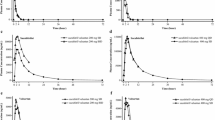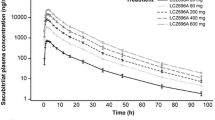Abstract
Objective: This was a randomised, open, three-way crossover study in 12 healthy male volunteers to determine the effect of a single oral dose of cimetidine on the pharmacokinetics of a single oral dose of the angiotensin II receptor antagonist valsartan – and vice versa. The volunteers received either valsartan alone (160 mg), or cimetidine alone (800 mg), or valsartan 1 h after cimetidine. The study was designed primarily to detect a possible influence of cimetidine on the rate and extent of absorption of valsartan.
Methods: Plasma concentrations of valsartan and cimetidine, measured by means of high-performance liquid chromatography, were used to calculate pharmacokinetic parameters. The rate of absorption of valsartan and the fraction of the dose absorbed and systemically available after oral administration were calculated using data from an i.v. study with valsartan in healthy young volunteers.
Results: The pharmacokinetics of cimetidine – area under curve (AUC0–48 h), maximum concentration (Cmax), time to reach Cmax (tmax) and apparent terminal plasma half-life (t1/2) – was not changed by co-administration of valsartan. For valsartan, the AUC0–48 h increased by 7% and the Cmax by 51% (ratio of geometric means) with co-administration of cimetidine. The higher value for Cmax was attributed to the initial increase in the rate of absorption of valsartan: ka was increased 2.7-fold and another indicator for the rate of absorption, Cmax/tmax, 2.2-fold. This effect was ascribed to inhibition of acid secretion by cimetidine, which leads to a higher gastric pH, thereby increasing the solubility of valsartan; the t1/2 of valsartan was not changed. After valsartan alone, 19% of the dose was absorbed, 23% with co-administration of cimetidine. It was estimated that only 2.2% of the possible change in AUC might be missed by giving a single high dose of cimetidine instead of multiple doses, with the aim to optimally inhibit formation of the inactive metabolite of valsartan. Cimetidine-related changes in the rate of elimination of valsartan were not anticipated, since the clearance from plasma occurs mainly by biliary excretion of unchanged valsartan; metabolism and renal excretion are only minor contributors. Therefore, even in the clinically relevant situation with multiple doses of valsartan and cimetidine, notable changes in the pharmacokinetics of valsartan, except for an increase in Cmax, are not to be expected. This increase in Cmax appears to be of no clinical significance.
Valsartan alone and in combination with cimetidine was well tolerated by healthy subjects.
Similar content being viewed by others
Author information
Authors and Affiliations
Additional information
Received: 16 October 1996 / Accepted in revised form: 25 September 1997
Rights and permissions
About this article
Cite this article
Schmidt, E., Antonin, KH., Flesch, G. et al. An interaction study with cimetidine and the new angiotensin II antagonist valsartan. E J Clin Pharmacol 53, 451–458 (1998). https://doi.org/10.1007/s002280050406
Issue Date:
DOI: https://doi.org/10.1007/s002280050406




